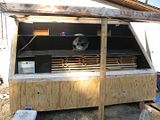First let me say that I am air drying my lumber and have no plans to do anything but air dry at least for now.
2 Questions:
I have heard that you need to leave it about 1 year, but there are lots of variables to account for that, and have heard that sometimes the wood can reach its outside moisture content in 6 months.....so....
1.) What should the moisture content be before being brought inside the shop to acclimate and to lower it moisture content more.
2.) What is a good moisture reader, I know there are some with pins, not pins, so what would you suggest.
Thanks
2 Questions:
I have heard that you need to leave it about 1 year, but there are lots of variables to account for that, and have heard that sometimes the wood can reach its outside moisture content in 6 months.....so....
1.) What should the moisture content be before being brought inside the shop to acclimate and to lower it moisture content more.
2.) What is a good moisture reader, I know there are some with pins, not pins, so what would you suggest.
Thanks


























































 You just can't compare the two. Water that is frozen solid in the cells of wood is not going to do anything until it thaws. Cut your firewood here too late in the season, you'll learn real fast how wood doesn't dry when frozen. If woodweb says it does, they never lived where there is a real winter.
You just can't compare the two. Water that is frozen solid in the cells of wood is not going to do anything until it thaws. Cut your firewood here too late in the season, you'll learn real fast how wood doesn't dry when frozen. If woodweb says it does, they never lived where there is a real winter.
